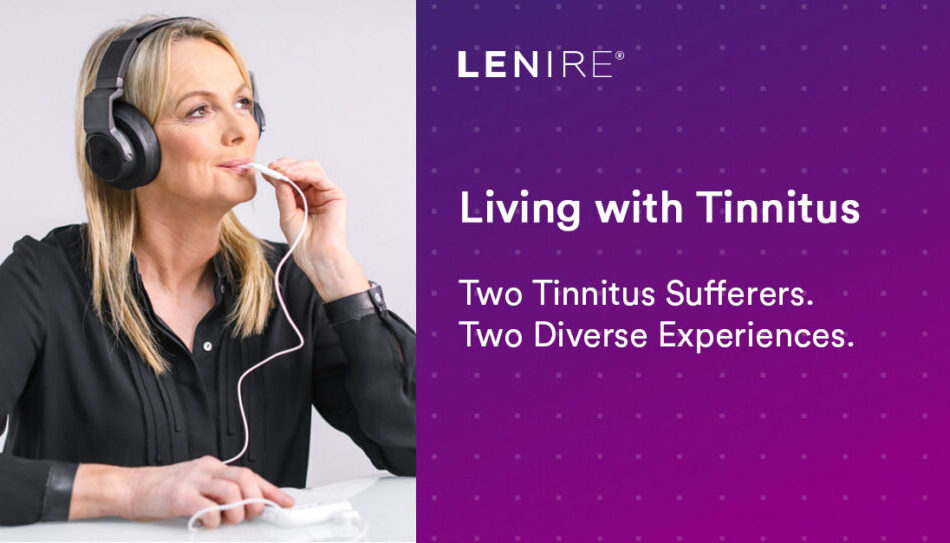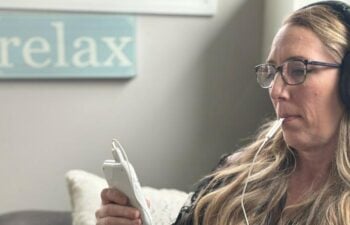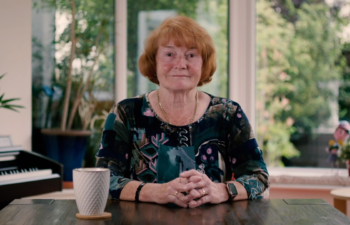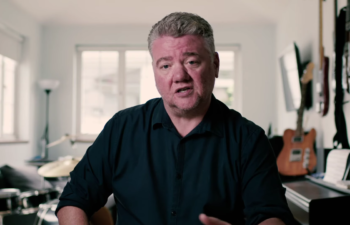Living with Tinnitus: Two Tinnitus Sufferers. Two Diverse Experiences.

Living with Tinnitus: Two Tinnitus Sufferers. Two Diverse Experiences.
This article was adapted from a Living with Tinnitus .de Article. It was originally published in German on the tinnitus self-help website “Hast du Töne?!” from Bergisch Gladbach.
“Higher…A little more…That’s ok.” Hearing care professional Heike Lohmann-Steireif enters data into her computer. She is currently fitting the patient Heiko with a Lenire device.
Heiko is currently giving feedback on the pitch and volume of his tinnitus. He wants to reduce the burden of tinnitus after years of struggling with ringing in his ears.
Neuromod Devices Ltd. has recently launched the Lenire Device. Behind Lenire is a new method for the treatment of tinnitus – bimodal neuromodulation.
Bimodal neuromodulation is the stimulation of two nerves at the same time. The Lenire device delivers gentle electrical pulses to a person’s tongue, combined with sound played through its headphones.
This combined stimulation of the nerves in the tongue and ears retrains the brain by increasing its sensitivity to many different sounds.
This in turn reduces its sensitivity to the sound of the tinnitus, making it less bothersome and ultimately improving the person’s quality of life.
Living With Tinnitus: The Tinnitus Patients
Heiko and Jutta are members of the tinnitus self-help group “Hast Du Töne?!” (“Do you have sounds?”). Together they travelled to Hörcentrum Lohmann in Pulheim. They want to try Lenire to share their experience with their network of tinnitus sufferers.
Both have different experiences with tinnitus.
Jutta has had ringing in her ears for about five months. Her tinnitus causes her distress, and she is desperately looking for therapy that works. Jutta does not want to accept this recent development in her life and will leave no stone unturned to find a tinnitus remedy that gets rid of the noises.
Heiko, despite his young age, is already an old hand when it comes to tinnitus. He has had chronic tinnitus for 20 years but a few years ago, he began experiencing a new tone that significantly increased his suffering. As a result, he repeatedly reports sleep disturbances.
Jutta and Heiko: Both are affected by tinnitus. Both have already explored several treatment options and are well informed about the phenomenon of tinnitus – through their own research, information, and through participation in the tinnitus self-help group.
Both hope for relief from the relief from tinnitus.
Hearing Specialists: Tinnitus Experts
Rüdiger Lohmann and his wife Heike Lohmann-Streireif take care of Jutta and Heiko. They are not only experts in hearing aid fitting but also in tinnitus.
With years of experience, they are familiar with the treatments available, and understand the needs of those affected. Particularly when patients leave a doctor’s office after being told, “There’s nothing we can do!” before they desperately turn to hearing professionals for help.
No help for tinnitus? The two hearing care professionals see it differently. “You can absolutely do something about tinnitus” they say unanimously.
The two have also shared their expertise with the Lohmann Tinnitus Center. Tinnitus patients receive 360° advice here, with tips on which tinnitus treatments might be best suited to their individual needs, from counselling to the use of eHealth.
“Because it’s possible” is their slogan. Behind it is the claim that sufferers can regain a better quality of life with smart tinnitus management. Lenire is part of the range of therapies that Hörcentrum Lohmann recommends depending on the patient’s situation.
Lenire is to be fitted for Jutta and Heiko today, provided they are suitable for treatment.
Tinnitus Patient Suitability
Before fitting the device for Jutta and Heiko, the specialists at Lohmann had to check that they met the following criteria:
- Patients should be older than 18 years and have chronic tinnitus that has not been present for more than 20 years.
- The treatment is suitable for subjective tinnitus, i.e., sounds that only the affected person can hear.
- Patients should not use Lenire if they have any of the following contraindications:
- They have a pacemaker, defibrillator, or any other active implantable device.
- They are pregnant, unless directed by a doctor.
- They suffer from epilepsy or any other condition that may result in loss of consciousness.
- They suffer from any condition that causes impaired sensitivity of the tongue.
- They have lesions, sores, or inflammation of the oral cavity.
- They are suffering from intermittent or chronic neuralgia in the head and neck area.
Jutta and Heiko pass these requirements easily. It is good news: they can use Lenire.
After the assessment, the patients go through four phases of Lenire fitting at Hörcentrum Lohmann’s studio. Jutta and Heiko finish fitting in one day but it can take multiple appointments.
The four phases; medical history, audiometry, short questionnaire, calibration and first test of the device will be described here.
1. Medical History and Audiometry
First, a thorough review of the patients’ medical history is carried out. Heike Lohmann-Streireif also interviews the patients to profile the patients’ tinnitus.
Jutta and Heiko discuss their medical history: which doctors were involved in their tinnitus diagnosis, how it was treated, where the tinnitus is localised, and how it can be described.
These are typical questions that every tinnitus patient knows.
The two patients also have their own questions: “Are there actually side effects with Lenire?” They know that patients can react differently to different tinnitus treatments. They wish to be informed.
“There can be an initial worsening of tinnitus, It is not unusual for tinnitus symptoms to fluctuate temporarily. Otherwise, headaches or a temporary numbness in the mouth are possible, but rare” Lohmann-Steireif said.
The clinician makes it clear that patients should report if there are any adverse effects so that it is possible to react swiftly. She is keen to provide close-knit support for the patients.
Following the medical review, she performs a hearing test and an approximate determination of the pitch and volume of the tinnitus.
“This is important to calibrate the Lenire device precisely to the individual patient” explains Heike.
This level of attentiveness shows why hearing care professionals are well suited to fit Lenire. General Practitioners often have high and rapid patient turnover.
Hearing care professionals have the necessary skills required to calibrate the Lenire device. They also possess empathy, tact, and counselling skills that a tinnitus sufferer needs.
It quickly becomes clear that tinnitus sufferers are in safe hands at Hörcentrum Lohmann.
Step 2 and 3: Short Questionnaire and Calibration
Heike Lohmann-Steireif calibrates the Lenire devices according to the patient’s hearing.
Meanwhile, Jutta and Heiko fill out a questionnaire: the Tinnitus Handicap Inventory (THI). THI is a clinical standard for measuring the impact of tinnitus on someone’s day-to-day life.
Measured on a scale of 0-100, the higher the score, the greater the impact of tinnitus. Reducing a person’s THI score and improving their quality of life is the aim of treatment.
“The patients complete the THI questionnaire at the beginning, after six weeks and after twelve weeks of treatment. In this way, we measure whether and how the user’s perception changes during treatment,” Rüdiger Lohmann explains. a person’s THI score treats how their tinnitus is affecting them and improves quality of life.
Step 4: First Device Test
Then it gets exciting: Jutta and Heiko try on their Lenire device. Each device has been custom calibrated for them. Lenire consists of a Controller, Bluetooth Headphones, and a Tonguetip which delivers mild and safe energy pulses to the surface of the tongue.
Lenire’s audio is configured by the clinician based on each patient’s hearing. The Tonguetip is also recalibrated at each appointment. Users can readjust both on the controller if needed.
The two patients listen to the sound stimulation through the headphones. Their eyes grow wide with surprise. It sounds a bit like the sea, paired with harmonic sequences of variable sounds.
“It changes a little during use” describes Heike-Lohmann-Steireif.
Enthusiasm Versus Hesitance
Heiko is enthusiastic after a short trial run; the initial surprise at the sounds quickly turns into trust and well-being: “It’s very relaxing” he concludes. He is already looking forward to using it in the evening; the sounds are super.
Jutta is different. She struggles with the setting, and finds the acoustic stimuli take some getting used to. Lenire’s volume is adjusted and many different settings are applied. It is not love at first sight for Jutta and the Lenire device.
Now they are ready to begin treatment. Lenire devices are packed up for them to take home. Jutta and Heiko should use the device for an hour a day if everything goes smoothly.
Heiko: “I Enjoy the Downtime!”
After about a week, Heiko is still enthusiastic about his Lenire system. He uses it in the evening, on the sofa. “I enjoy the downtime,” he says.
Handling and recharging the device runs smoothly, he says. He looks forward to the acoustic downtime – the headphones do not let any outside noise through. The electrical stimulation on the tongue was also “pleasant.”
“I was clearly more relaxed after using Lenire, and had the feeling for a few days that the tinnitus was a little less annoying,” he concludes after the first week. He emphasises above all the relaxation effect and wants to continue treatment.
Jutta, meanwhile, needs more support. She turns to Hörcentrum Lohmann for help with adjusting the intensity of the electrical stimulation. This is no problem.
The treatment plan includes close-meshed support from the clinic, working with Neuromod.
Different Success Levels
“After six weeks of treatment with Lenire, a short check-up is planned, as well as a device adjustment. A final appointment is held at the end of the treatment,” Heike Lohmann-Streireif describes.
She and her team are always available to answer questions so Lenire treatment can be explained and patient progress is easily observable.
One example: “If a patient reports social withdrawal and irritability at the beginning of treatment, but at the end tells us about a nice meal with friends, then we can read that the treatment has been successful,” says the hearing care professional.
Improvement is reflected in patients gaining a better quality of life. It does not always have to be a reduction in suffering or a lowering of the volume of the tinnitus.
She stresses that patients should make time for treatment. “Unforeseen things always happen, but basically it’s advisable to realize when starting with Lenire that you should give the treatment some time in your daily routine.”
Jutta: Consistent Use is Difficult
Jutta finds it difficult to make time for the treatment in her daily routine, in her professional life. At first, her tinnitus reacted intensely to Lenire: “At times, I had the feeling that Lenire was really triggering noise in my ear,” she reports.
The ENT adjusted stimulation and treatment improved afterwards. Still, she must try to use it, which is not easy for her. But she makes no secret of that.
“An hour at a time was hard for me to do,” she says. She tried 30-min sessions, morning, and evening. However, she took entire days off when the pressure of suffering became too great.
“You should try to use Lenire for one hour a day,” suggests Heike Lohmann-Streireif. In Jutta’s case, it was necessary for her to use it as much as she could tolerate.
Living with Tinnitus: Was Lenire Treatment Successful?
There comes a significant interruption: Jutta had to undergo surgery followed by rehab and she chooses to take a long break from Lenire. Her tinnitus worsens because of the operation and the accompanying pain. Jutta does not want to continue with Lenire until she recovers from her operation.
What happens now? Has Lenire helped despite everything? “No,” says Jutta. She cannot make a connection between the use of the device and a reduction in suffering or volume.
Nevertheless, she is optimistic:
“I know that with the device I have an option to address my tinnitus.” That gives her security, creates confidence and she wants to try it again.
Now that she has recovered, she is starting treatment with Lenire all over again. And hopes she can build on her experience.
“The possibility for relief exists and that is why no one should be discouraged from pursuing alternative paths or trying new therapies. Lenire is one of them,” Jutta concludes.
Heiko: A Refreshing Enjoyable Break
Heiko’s experience is different. He continuously sticks to one hour of use per day, “even on vacation,” he says. He found that he does best with it in the evening.
“After using Lenire for 1 hour per day, I was usually refreshed – it did me good,” he concludes.
He also copes well with the stimuli. “The sounds were good, even after the planned variation after six weeks. Even the electrical pulses on the tongue were pleasant.”
Heiko was open and pleasantly surprised from the beginning and followed through with the treatment. Perhaps his experience helped him. Chronically affected people usually have more therapy and often approach new forms of treatment with lower expectations.
The questionnaire at the end of treatment shows a slight improvement in how he feels. “The volume has remained the same,” he says. “But my level of suffering has decreased.” For him, the treatment is now complete. He looks back on the experience with satisfaction and plans to report on the therapy in his support group soon.
He finds new therapy methods good but looks skeptically at Lenire’s sales model. “The purchase price creates a corresponding expectation on the part of the customer, so the fall-out is naturally all the greater if the therapy doesn’t work,” he says.
We asked: According to Neuromod Devices, the company behind Lenire, the cost is due to several reasons. Neuromod invested heavily in research and large-scale clinical trials to develop the sophisticated medical device, Lenire. As well as this, Lenire is a novel treatment and, as a result, is not currently covered by health insurance.
Heiko also asked whether special headphones included in the package with Lenire are necessary. In his eyes, it limits flexibility a bit.
We also asked Lenire for a statement on this: “Lenire is designed to only work with the included headphones,” they say, “The reason is that the timing of the electrical stimulation of the tongue and the sounds played through the headphones is extremely important and must be very precise. With other headphone models, there are issues with latency, which delays the sounds being played at the right time to accompany the electrical stimulation.”
Living with Tinnitus: Lessons Learned
Two users, two completely different therapy experiences: Two members of the tinnitus self-help group were able to have an interesting experience with a novel tinnitus treatment and try Lenire for themselves.
They experienced the therapy in diverse ways. The experience ranged from scepticism about Lenire to an “oasis of calm and retreat”.
Lenire provides a new approach to tinnitus treatment to give sufferers back a greater quality of life. It does not always have to be a reduction in the level of volume.
Sometimes a treatment like Lenire is enough to simply give sufferers a “time out” from the noise in their ears. Awareness alone is – as sufferers will know – invaluable in the lives of tinnitus sufferers.
However, Jutta and Heiko’s test also showed that tinnitus, its cause, and the mechanisms of action of therapies are as different as people are.
In this respect, approaches such as the international UNITI project, which aims to develop customised therapy approaches for tinnitus patients based on artificial intelligence and databases, are an important and central path in the management of tinnitus.
Lenire’s bimodal neuromodulation approach is a building block, depending on the patient’s situation.
The good news for sufferers is that something is happening, the research and the healthcare industry are moving in the right direction!
Editorial Notice: Hörcentrum Lohmann has since changed ownership. Neuromod recommends interested parties to contact their nearest Lenire partner clinic from www.lenire.com/find-a-clinic to start tinnitus treatment with Lenire.



